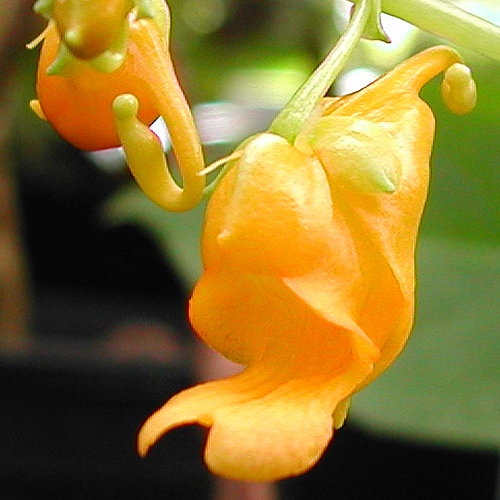Growing the seeds
When to plant -- Plant your seeds when you receive them for best germination Use a very well-draining soil. A typical
mix is mix is
1 part
quality potting soil Fill the pots, without packing down the soil, and place a seed or 2 on top. Tap the pot gently to settle the seed in the cracks of the soil. If you have
long-fibered sphagnum moss Until the seeds sprout, ensure that the surface soil always stays moist. A plastic dome may be used to maintain moisture, but leave it open slightly to allow some fresh air in. You may need to drip a few drops of water over the seeds every day to keep the surface (and any moss) moist. They sprout well between 68 and 80 degrees F (20-27°C).
I have no experience germinating them outside that temperature range. I
recommend placing a
minimum/maximum thermometer A bright LED bulb kept 3-4 inches (8-10 cm) away provides the right amount of light (See: "Growing indoors with LED lights"!). Protect from direct sun. The seeds can sprout at different times, usually between 3 weeks and 3 months. Continue keeping the soil surface moist for 3 weeks after they sprout, and then remove them from any plastic dome. Fertilizing -- Once they are a few days
old, give a small
amount of dilute (1/8 strength) liquid fertilizer.
Hydroponic fertilizer
is ideal for this, because it is easily absorbed and contains all essential
nutrients. Repat 2 and 4 weeks later. After that, you may switch to a granular fertilizer Lighting -- It grows well in bright shade, dappled sunlight, or weak sun. But avoid strong sunlight until the plants are a few months old. It will probably need some protection from strong afternoon sun. Transplanting -- When your plants are about 2 inches tall (5 cm), gently transfer them to pots about 3 inches tall (8 cm). Avoid disturbing the roots when repotting. Watering -- Try to keep the soil moist most of the time. Avoid letting it dry out completely, but don't keep it constantly soggy. Climate -- This is a tropical species that does best above 60 degrees F (15°C). It tolerates heat fine, but it seems happiest between about 65 and 85 degrees F (18-30°C). The tuber can probably survive a light frost, but i recommend keeping the plant above 50 degrees F (10°C). Pests to watch for -- Watch for any pests that can affect your other plants. Be careful when choosing chemical remedies, as some may harm the plant. If you have any questions, feel free to contact me. Have fun growing them! - Jeff Strange Wonderful Things
|
|||||||||


